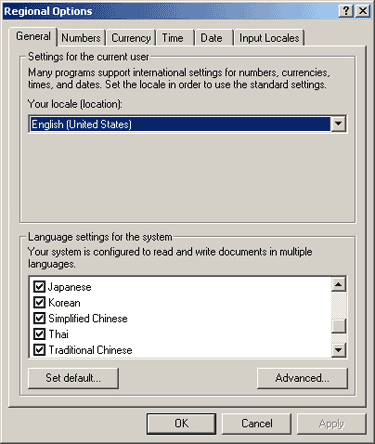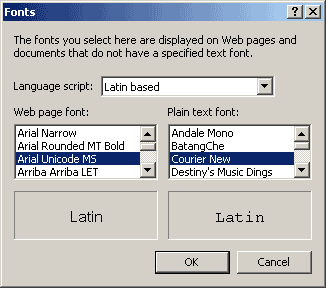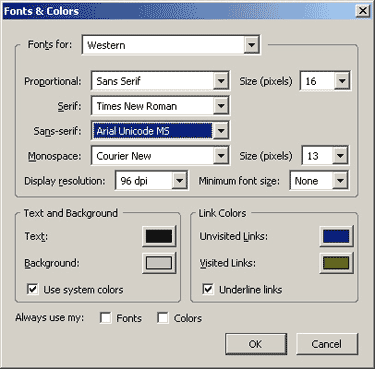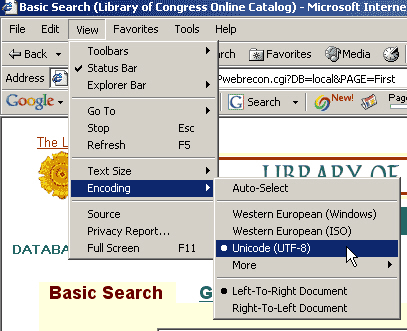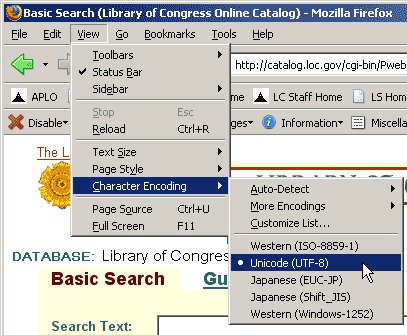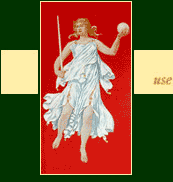

Displaying and Searching Diacritics and Special CharactersAlthough there are no non-Roman characters in LC authority records, users still want to adjust their browsers in order to display all diacritics and special characters in authority records. Authority records for items in most languages will display correctly without changing any settings in your preferred Web browser. The instructions below may be helpful if you want to view authority records containing diacritics and special characters. Instructions for WindowsInstalling the Unicode Font in Windows XPIf you are using Microsoft Windows XP, the "universal font" for Unicode should be automatically installed. Arial Unicode MS font is a "full Unicode font" -- it contains all of the characters, ideographs, and symbols defined in the Unicode 2.1 standard.* * Unicode is a character encoding standard developed by the Unicode Consortium. By using more than one byte to represent each character, Unicode enables almost all of the written languages in the world to be represented by using a single character set. If the "universal font" is not visible (i.e., you cannot see diacritics and special characters), you will need to set the Latin-based font to Arial Unicode MS (if it is not available on your system, you may need to install it -- it will be called "Universal Font" on the installation disks.) Installing the Unicode Font in Windows 2000To display diacritics and special characters:
If you have Microsoft Office 2000 and newer versions, you can install the Arial Unicode MS font, which supports display of most of the diacritics and special characters. If you don't already have this font:
More Information for Windows 2000 Users: http://office.microsoft.com/en-us/assistance/HP052558401033.aspx Displaying Diacritics and Special Characters in Web BrowsersSetting up the browser to display diacritics and special characters is a 2-step process. Begin by setting the default font to Arial Unicode MS: STEP 1:To set the font in Internet Explorer, from the Tools pulldown menu:
To set the font in Firefox, from the Tools pulldown menu
STEP 2:When viewing catalog records, you will also need to make
sure that the character encoding for the page you are looking at
is set to Unicode (UTF-8). Often, the browser
sets the encoding automatically. You may
also have to choose the setting yourself, and this setting doesn't
always "stick" (so you may have to reset it).
To set UTF-8 encoding in Firefox... from the View pulldown
menu
Installing IMEs for Entering Non-Roman CharactersBecause there are currently no non-Roman characters in the Library of Congress Authorities catalog, users may not need to install the IMEs (Input Method Editors) in order to search and display non-Roman characters. If you wish to install IMEs, please view the help screen on installing IMEs in the Online Catalog help areas. More on Displaying Diacritics and Special Characters on Macintosh Computers
This information comes from the Unicode Web site: On Mac OS X, the Safari Web browser includes Unicode support as does OmniWeb. OmniWeb, however, does not currently provide support for all of Unicode (it can, however, take advantage of Unicode fonts for Windows if properly installed). Earlier Versions There are currently no Web browsers which provide direct Unicode drawing (font support) on the Mac OS 9.x or earlier. All the browsers use Apple Language Kits and WorldScript to varying degrees to support Unicode and international text. Language Kits are installed using your Mac OS 9.x installation CD. Launch the Mac OS Install application. Proceed through the initial screens, selecting the appropriate boot disk. When you reach the "Install Software" screen, click on the "Customize" button. This opens up the Custom Installation and Removal dialog box. Scroll down to "Language Kits." Click on the check box, and then select "Customized Installation" from the installation popup to the right. (It will say "None selected" at first.) This brings up a dialog box with a list of all the available language kits. Select the ones you want, or use the menu at the top of the dialog box to select all of them. Proceed with the installation. If you already have Mac OS 9.0 installed, you will be asked if you want to add or remove software after you select the installation disk. Click on the "Add/Remove" button. This will bring you to the Custom Installation and Removal dialog box. The installation procedure is the same for Mac OS 8.6, except that you will be installing "Multilingual Internet Access" instead of Language Kits. For Mac OS 8.5.5 and earlier, it will be necessary to purchase the individual language kits. Use the browser's [Back] button to exit help and resume searching. |
Still need Help?
Library of Congress Online Catalog - catalog.loc.gov
The Library of Congress Home - www.loc.gov
September 26, 2006
